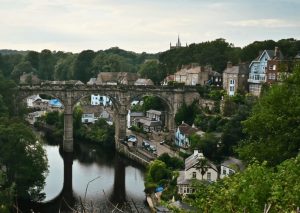
Are you looking to explore London away from main tourist attractions? Do you love walking and history? If the answer is yes to both, I think you will love the walk from Tower Hill to Canary Wharf.
Along this section of the Thames Path you will find many hidden gems away from the crowds. Once upon a time this stretch of land and water was a criminal hotbed for seedy activities, pirates, and smugglers bringing stolen goods into London. Don’t worry, it’s certainly not like that now, but glimpses of the past still remain if you know where to look.
To truly appreciate this route, I have weaved in a few historical figures and overlooked landmarks to really bring this riverside walk alive. While it has certainly been cleaned up through major redevelopment, fascinating reminders of this bygone era can still be found.
This section of the Thames Path churns up some real hidden treasures for those that are willing to explore the lesser-known pockets of London.

Overview of walking route
Start/Finish: Tower Hill and Canary Wharf
How to get there: Begin at Tower Hill Station which is served by the Circle line and DLR. It is also easy to reach from Bank and Monument Station by foot.
Distance: Approx 6 – 8 miles (depending on how much you veer away from the main path)
Time to complete: 3 hours (without stopping for beers!)
Difficulty: Easy


Tower Hill to Canary Wharf walking guide
To make this guide easy to follow, I’ve broken it up in sections and provided highlights along the way. Hopefully you’ll find the route as interesting and enjoyable as I do!
Tower Hill to Tower Bridge
From Tower Hill Station, you’ll head toward Trinity Square Gardens, where a poignant Memorial to Merchant Navy Sailors commemorates lives lost in the World Wars. The lush green space is a peaceful contrast to the medieval grandeur just ahead.
The Tower of London
From here, cross the street and you’ll see the Tower of London, one of the city’s most famous landmarks. Originally founded by William the Conqueror in 1066, this fortress has served as a royal palace, prison, and treasury.
The Tower of London’s history is filled with dark and grisly tales, most notably the execution of Anne Boleyn, Henry VIII’s second wife. He accused her of adultery, incest, and treason, though these accusations were most likely fabricated. In reality, the king just needed an excuse to get rid of her so he could marry Jane Seymour. A truly ghastly man! In 1536 her fate was sealed within the tower walls. Poor lass.
As you approach, you’ll notice Tower Bridge nearby. The Traitors’ Gate entrance hints at the Tower’s grim past, as many, including Anne Boleyn, Guy Fawkes, and the Kray Twins passed through here for imprisonment. The notorious Kray Brothers were actually some the last people to be imprisoned in the Tower of London for a brief period of time.
In hindsight, maybe the brothers should have been kept in there for longer. Afterwards, they would go on to run their gangland empire across London.
Tower Bridge to St Katherine Docks

The walk from the Tower of London to St. Katharine Docks begins at the Tower’s main entrance, heading east toward Tower Bridge. Follow signs and walk past the Tower moat, with the bridge in view. Cross over the pedestrian path and turn left onto St. Katharine’s Way.
St Katherine Dock is a gorgeous marina, home to some very impressive yachts, boats, cafés, shops and historic warehouses. One of these historic warehouses is Dickens Inn, a former teahouse that has been converted into a pub. This wonderfully preserved wooden structure is one of only a handful of buildings in the area to survive the Blitz of World War II.
Exiting the dock, you will be greeted by a wonderful sculpture, The Timepiece Sundial, with fabulous views of Tower Bridge behind.
At the end of St Katharine’s Way is Alderman Stairs, the first of several historic passageways that lead out onto the Thames. These ‘hidden’ stairs are also known as watermen’s stairs in ode to the men who would ferry people back and forth across the Thames before the consecration of bridges and piers.
During low tide you can walk out onto the beach for a different perspective. However, during high-tide this isn’t possible so be sure to keep a safe distance. These passages are easy to miss so keep your eyes peeled for gaps between buildings as they really do make the Tower Hill to Canary Wharf walk more interesting.
St Katherine’s Dock to Wapping


Following the Thames Path, you’ll hit Wapping High Street. During the 17th and 18th centuries, Wapping High Street became lined with warehouses, inns, and taverns catering to sailors, merchants, and dockworkers. Today, some legendary pubs still exist, thankfully with their character still intact.
Okay, you have two options next. You can either continue onto Wapping High Street, or turn up onto Hermitage Basin. From there you will continue onto Ornamental Basin, passing through Tobacco Docks and onto Shadwell Basin. I like them both but for this blog post I’m going to focus on Wapping High Street. If you have time, I suggest heading up there before returning back to this location.
Wapping High Street
Admire the old victorian warehouses that line Wapping High Street. Take a look down Wapping Old Stairs, another look out point over the Thames.

Just after you will arrive at Waterside Gardens on your right-hand side. It is essentially a viewing area with a few benches overlooking the Thames and the Metropolitan Police Marine Unit. I don’t ever recall seeing police boats along the Thames, until I spotted them docked here.
When the Police Marine Unit was established in 1798 it was one of the world’s earliest police forces formed to combat piracy on the Thames. I’d say it had a much more action-packed time back when this part of the Thames was rife with illegally traded goods.
Shortly after Wapping Station, I came across ‘New Crane Stairs’, another wonderful passageway that leads onto the Thames. When the tide is low, you will be able to walk along the slim stretch of beach that stands between the water and the wharf buildings. If the tide is high, this won’t be possible, so be careful on the stairs and turn back the way you came.
The Prospect of Whitby and Execution Dock
Next up is the Prospect of Whitby, a gorgeous old pub, and reportedly London’s very oldest, having been built in the 1500’s. This is one of the most historic pubs in the city where smugglers and pirates once mingled.
The Prospect of Whitby was a hub for smugglers and pirates who used the river to carry goods in and out of London. The pub’s cellar was rumoured to be used as a hideout for illicit trade, and sailors could enjoy a drink while evading authorities.
Around the side of the pub, you will spot ‘Pelican Stairs’, that leads to the infamous Execution Dock. Here, people would watch over the execution dock from the pub as pirates and criminals were dragged down the stairs and hanged. Today, a noose hangs by the riverside as a reminder of this dark connection. I told you this walk had some macabre tales…

On a more cheery note, the pub has long attracted artists and writers, including Charles Dickens, who reportedly found inspiration here for his colourful portrayal of East End characters.
Additionally, artists like James Whistler and J.M.W. Turner sketched and painted views of the Thames from the pub’s terrace, drawn to its riverside vantage point.
Wapping to Limehouse via Shadwell

Just before I reached Edward VII memorial Park, I crossed over the impressive red bascule bridge at Shadwell Basin. It is exactly like the bridge I crossed over at Rotherhithe when I walked from Greenwich to Tower Bridge on the other side of the Thames – another London walk I highly recommend!
Admire the view of Shadwell Basin from where the London skyline creeps up from behind warehouses and new apartment developments. If time permits, take a stroll around, otherwise head over to King Edward Memorial Park.
King Edward Memorial Park & Captain Cook Blue Plaque
Inside the park you will find a small memorial plaque dedicated to Sir Hugh Willoughby. In 1553 he led three ships from London to seek out a North-East passage around the Arctic Ocean to China. They successfully navigated around the top of Norway and into the White Sea off the northern coast of Russia.
In the summer it’s a lovely place to relax – you’ll hardly notice that a busy main road sits on the other side! Unfortunately, you will have to exit onto the main road, but only for a couple of minutes before making the detour back onto the Thames Path.
As you exit the park, be sure to look out for the Blue Plaque dedicate to Captain Cook. It reads, “Captain James Cook ‘The ablest and most renowned Navigator this or any country hath produced’ lived in a house a few yards from this spot. 126. Upper Shadwell 1763 – 1726”.
Ironically, despite his fame and high regard, the placement of the plaque on a random unforgettable building overlooking overlooking traffic seems rather underwhelming. I would have expected him to be placed inside the park or somewhere more noticeable. Strange decision, eh?
Soon you will spot a sign for the Thames Path directly in front of a pair of big black gates. Ignore these gates which seemed to be for private access, instead walk on for a few steps to another entrance that’s for the general public.
Limehouse to Canary Wharf
After weaving between the cobbled streets and the river street, the next attraction I want to show you is The Grapes Pub. Along with the Prospect of Whitby, The Grapes is my favourite pub along the walk from Tower Hill to Canary Wharf.
Inside The Grapes Pub

Now is the time for a cheeky beer stop. It has everything you could ever wish for in a cosy British pub with bags of character. If you’re a Lord of the Rings fan, you will be excited to see Gandalf’s stick resting behind the bar.
You might be wondering why it’s in this pub of all places? Well, Gandalf himself, aka Ian McKellen, owns the pub! FYI, reportedly, he turns up occasionally on Quiz night. You should try your luck!

Be sure to head outside onto the small terrance that resembles a boat deck. The view across Canary Wharf is incredible, and you will find an extra surprise in the form of Antony Gormley’s statue ‘Another Time. When the tide is hide its looks like the figure is floating on water.
St Anne’s Church


Afterwards, carry on walking down Narrow Street admiring all the wharf buildings, and take a detour up Three Colt Street to St Anne’s Church. The Churchyard is a treasure chest of sorts, scattered with gravestones, tombs and leafy trees. Look out the pyramid monument. I can’t tell you much about it, but it’s very striking. Also, an impressive war memorial the lines of headstones against the brick wall in the car park really do give Edgar Allan Poe vibes.
Film trivia: In 20 Days Later, Cillian Murphy’s character Jim is attacked by an infected priest at the church.
After your detour to the church, head back down to Narrow Street and follow the Thames Path to Limekiln Dock. Cross the footbridge that takes you to the Isle of Dogs. Despite its name, it isn’t actually an island, but a peninsula that’s surrounded by the Thames on three sides. It’s a popular residence for people who work in Canary Wharf – which is only a few minutes away by foot!
Canary Wharf & the Dockland’s Museum
Depending on what time you arrive, the perfect finale point of your walk should be a trip inside the Dockland’s Museum. The museum offers a fascinating journey through London’s maritime history, set in a former 19th-century sugar warehouse in Canary Wharf.
After all the historical places you have walked through, the museum will help stitch everything together in a timeline. It delves into the city’s dockside heritage, exploring themes of trade, migration, and commerce that shaped London as a global city.
Lastly, the exhibition also covers the decline of traditional dock industries and the regeneration of the area into the financial district where you will finish your walk.









